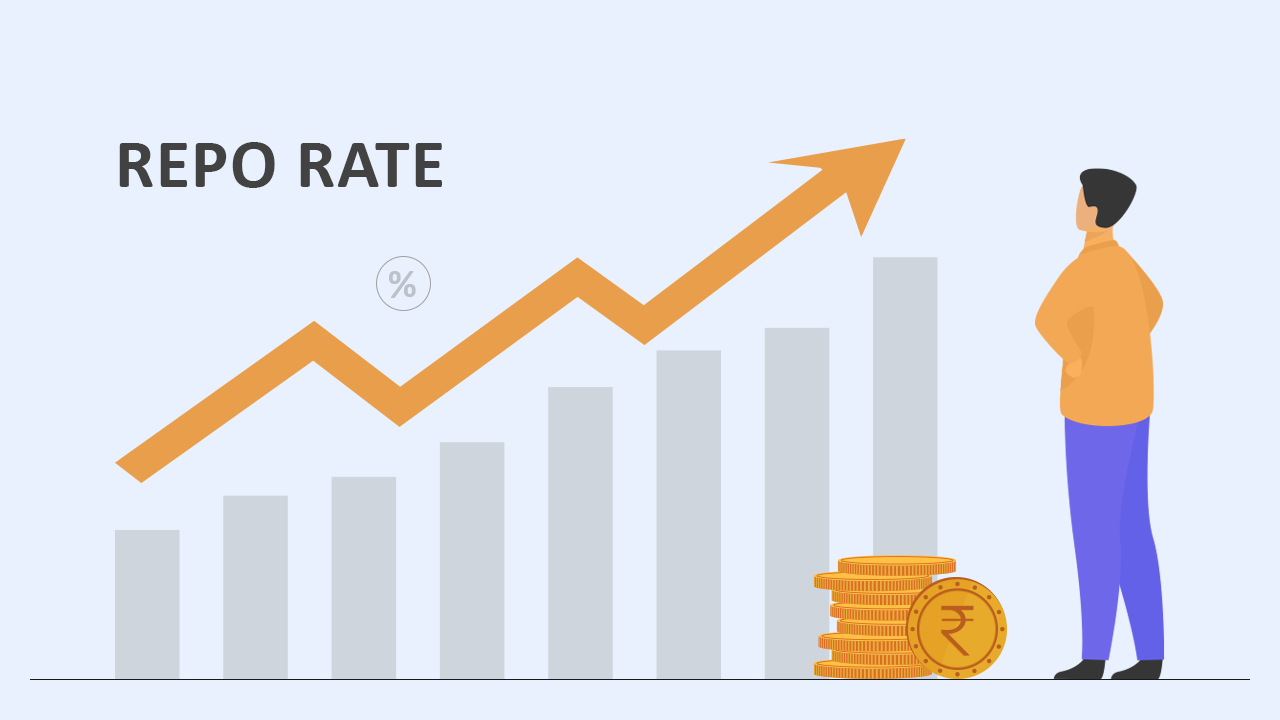The Monetary Policy Committee may decide to keep the repo rate at 6.5% in 2023

The Monetary Policy Committee may decide to keep the repo rate at 6.5% in 2023
The Reserve Bank of India’s six-member monetary policy committee (MPC) has scheduled a meeting from August 8 to August 10. Based on a survey of 12 analysts, the committee is expected to vote to maintain the benchmark repo rate at 6.50%.In April 2023, the RBI’s MPC paused after increasing the repo rate by 250 basis points (bps) since May 2022. Initially, they had voted in favour of this decision.
Aditi Nayar, senior economist at ICRA Ratings, predicts that increasing vegetable prices will cause consumer price inflation (CPI) to surpass 6% in July. That average CPI inflation for this quarter would be higher than the MPC’s most recent Q2 forecast from June 2023. India’s CPI inflation increased to 4.81% in June for the first time in five months.

Regarding the repo rate stance in the forthcoming policy review, the MPC is expected to be “fairly hawkish,” Nayar added.
The CPI prognosis for Q1FY24 was drastically reduced by the RBI from 5.1% to 4.6% in its June forecast. The estimate for Q2 was also reduced from 5.4% to 5.2%, while the projections for Q3 and Q4 were left constant at 5.4% and 5.2%, respectively. Senior economist at DBS Bank Radhika Rao had similar sentiments. While the MPC will vote to pause, she added, the accompanying statement is anticipated to note the supply-driven rapid increase in food inflation in Q3, which was led by a few pockets, notably perishables like vegetables, foodgrains, and pulses.

She said that the MPC will emphasize the need to review the official inflation prediction for July to September 2023 while characterizing these supply shocks as temporary and weather-related. However, she said that administrative actions and seasonality considerations will decrease food prices towards the end of 2023.
Although Ashima Goyal and Jayant Varma, the MPC’s external members, told FE last month that the June CPI figure will not significantly influence the predicted retail inflation trajectory for the current fiscal, economists still anticipate a revision to the MPC’s CPI prediction. “Food prices are erratic during the monsoon but also transient, so they are not expected to cause major changes in expected retail inflation,” Goyal added.
Most economists say the RBI’s “withdrawal of accommodation” policy won’t alter. According to Gaura Sengupta, chief economist of IDFC First Bank, there are two main justifications for maintaining the existing stance. First, there are upside risks to CPI inflation due to the spike in food prices in July, and second, FY24 CPI inflation is anticipated to average 5.4%, with Q2 numbers averaging 6%.
Second, notwithstanding a temporary impact from the removal of the $2,000 banknote, the core liquidity surplus is still relatively high, thanks to a significant increase in the balance of payment surplus in Q1FY24. She added that to remove liquidity and keep overnight rates close to the repo rate, and the RBI has started conducting reverse rate auctions.

“MPC will not shift its position on this policy given the impending threat of food inflation. They would instead watch for a decline in food costs, according to Soumyajit Niyogi, director of India Ratings & Research.
The experts agreed that the central bank is unlikely to lower the repo rate this year and will focus on doing so only in the first quarter of the following fiscal year.
“Given that inflation is still a worry and GDP is holding up well, we do not anticipate a rate decrease this fiscal year. The first quarter of the upcoming fiscal year may witness a rate reduction of 50 basis points, according to Rajani Sinha, chief economist at CareEdge Ratings.
Head of South Asia economic analysis at Standard Chartered Bank, Anubhuti Sahay, predicted a first-rate drop of 25 basis points in June 2024. Sahay anticipates a short rate reduction cycle, with a total rate decrease of 50 basis points, in the upcoming fiscal year due to rising global rates, concerns associated with sticky inflation, and robust growth.
Sujan Hajra, chief economist and executive director at trading company Anand Rathi, said he wants the MPC to stay the same course and decrease interest rates in the upcoming 12 months. Although the EU and US’s current policy rates are approximately 400 basis points higher than their long-term averages, he noted that these nations maintained a very accommodating monetary policy from the start of the global financial crisis in 2008 through 2021.

“As a result, it isn’t a good idea to return to the average policy rates from before. According to the IMF, the inflation rates in the US and EU will only reach their respective central banks’ comfort levels by 2025. Therefore, a considerable rate reduction in these areas until the second half of 2024 seems improbable, according to Hajra.
According to analysts and economic experts, the Monetary Policy Committee (MPC) of the central bank may vote to hold the repo rate at 6.5% in 2023. This decision has garnered attention, reflecting both the current state of the economy and the future monetary policy direction. In this article, we’ll delve into what this decision means, the factors influencing it, and its potential impact on various sectors of the economy.
The repo rate is the interest rate at which the central bank lends short-term money to commercial banks. It is crucial for regulating money supply, controlling inflation, and stabilizing the banking system. A change in the repo rate impacts borrowing costs for businesses and consumers, ultimately affecting the broader economy.
Several factors have led to the speculation that the MPC may opt to maintain the repo rate at its current level.
Holding the repo rate balances managing inflation and supporting economic growth. Lowering the rate might fuel inflation, whereas increasing it could hinder growth.
The global economic situation and domestic economic recovery may require a cautious approach. The central bank would provide continuity and stability to businesses and investors by keeping the rate steady.

With ongoing global economic uncertainties, such as the aftermath of the COVID-19 pandemic, trade tensions, and geopolitical issues, a steady monetary policy might be considered a safe and prudent course of action.
The government’s fiscal measures and economic impact also influence the MPC’s decision. A change in the repo rate might not align with the fiscal policies in place, causing conflicts in financial management.
Holding the repo rate at 6.5% would maintain the status quo for banks, impacting their lending rates and profit margins.
A steady repo rate generally means no immediate change in home loan interest rates, which could influence buyers and developers in the real estate market.
Industries relying on borrowed capital may welcome a steady repo rate as it provides certainty in their planning and investment decisions.
For consumers, holding the repo rate might translate into stability in the interest rates on loans and deposits, affecting savings and spending patterns.
The MPC’s decision to hold the repo rate at 6.5% in 2023 would likely be a complex balance of domestic and global factors, reflecting the central bank’s read on the economy’s current state and prospects.

While some sectors might welcome continuity and stability, the decision would also be closely scrutinized for what signals the central bank’s confidence in the country’s economic trajectory.
As always, the impact would depend on many factors, and only time will tell how the decision plays out in the economic landscape.




